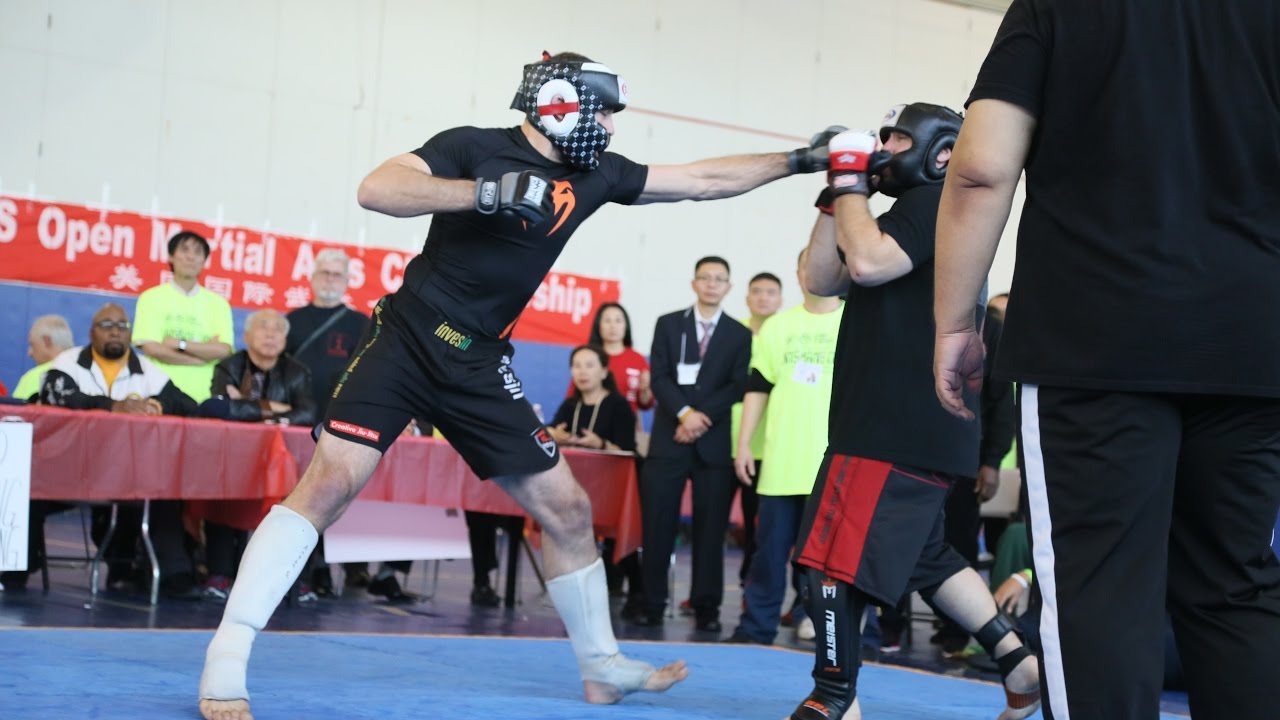Rules for Ultimate Sanda
General Rules
- Ultimate Sanda is for Advanced Level competitors only; Age Limit: 18 – 45 yrs.
- If there are less than 2 competitors in an age group, the judges reserve the right to combine age groups.
- Mandatory Safety Equipment: Headgear without Face Shield, open-finger “MMA Style” gloves (4-6 oz), mouthpiece, groin cup, shin guard, and foot protector (No Shoes). Shorts are MANDATORY – NO Long Pants.
- Striking Areas: Padded area of headgear, front of the face, chest, stomach, thigh, and lower leg.
- No Contact Areas: Back of the head, eyes, neck, spine, groin, and knees.
- Legal Techniques: Punches to the head and body while standing; Kicks to the head, body, and legs while standing; Throws and takedowns; Joint-Lock or Jujitsu techniques while on the ground.
- Prohibited Techniques: elbows, knees, headbutt, and small joint manipulation (fingers & toes). body slam, and spiking (Spiking is defined as throwing a competitor directly down on their head in a linear fashion). Once the opponent is down on the ground, no more striking permitted.
- Takedowns are allowed with a maximum of 6 seconds to execute.
- After a successful takedown, both competitors can use joint-lock techniques only, with a maximum of 10 seconds allowed to execute joint-lock techniques after a successful takedown. No striking allowed while on the ground.
- To stop the opponent from finishing a lock, the competitor can tap his/her hand on the floor or on the body of the opponent 3 times. If the competitor is not able to use his/her hand to tap, he/she can tap verbally by saying the word “STOP” one or more times. After tapping physically or verbally, the competitor’s opponent wins the bout.
- Weigh-in time is 8a.m. to 9:30a.m. at the Ultimate Sanda ring. If a competitor missed the weigh-in time, weigh-in will take place at the time when the competitor is called to compete.
Duration of Bout
- Each bout is 3 rounds; each round is 2 minutes with 1 minute rest in between each round. A competitor winning the first 2 rounds wins the bout, without going into the third round.
Scoring Points
- There are 3 aspects in Ultimate Sanda scoring: Stand Up, Takedowns, and Ground Control scores.
- Stand Up: Three Judges will score each competitor based on landed strikes (Punch or Kick).
- No Point: Glove to glove contact, clash of kicks, and slap punches while in a clinch do not count as points.
- No Point: A kick that lands but is caught by the receiving competitor and the receiving competitor follows with a counter that lands effectively, or a throw/sweep that is executed effectively, the kick does not count as a scoring.
- 1 Point: Strike landed clean to legal striking areas.
- 2 points: Any knockdown from a strike (Punch or Kick) to the legal striking areas will award 2 points to the striker as long as the technique is clean and while the striker remains standing.
- Takedowns: After each throw, takedown, sweep, etc., the match will continue for a maximum of 10 seconds on the ground to execute joint-lock or jujitsu techniques.
- No Point: If a competitor attempts a throw and his/her opponent pulls the competitor down with them, and neither shows control.
- 1 Point: If a competitor throws his/her opponent on the ground by falling down himself or herself deliberately and does not immediately stand up in a flowing motion.
- 1 Point: If a competitor being thrown uses a throw counter technique and reverses the beginning thrower and ends up in the controlling position after both competitors hit the floor shall award 1 point. If both competitors end up side by side, no points shall be awarded.
- 2 Points: If a competitor throws his/her opponent on the ground while remain standing.
- 2 Points: If a competitor throws his/her opponent on the ground by falling down himself or herself deliberately and immediately stands up in a flowing motion.
- Ground Control: If no submission is achieved, the action will be judged based on dominate position and threat of submission.
- 1) Dominate position (being in mount, back mount, side control, knee on belly, top half guard with control (in that order)).
- 2) Threat of submission (a threatening submission is defined as one where the submission shows a clear threat (such as an arm fully extended in armbar).
- Judges Scoring: At the end of each round, one competitor shall receive 10 points, the other less then 10. After initial score is written, fouls as indicated by referee shall be calculated in.
The winner of the bout is determined by
- At the end of the bout, unless the bout was stopped prior to the end of the scheduled rounds (TKO, DQ, Tapout, etc.), the competitor with the highest score wins.
- Competitor wins the bout by tapping out his/her opponent physically or verbally.
- If the competitor becomes disqualified by the judge, his/her opponent wins the bout.
- Forfeit by a competitor or his/her coach result in an automatic win for the competitor’s opponent.
- To forfeit, the competitor has to raise one hand and then verbally tell the referee that he/she is forfeiting this bout.
- If the competitor is on the ground and cannot raise either hand, then verbally tell the referee that he/she is forfeiting this bout.
- The competitor’s coach can also make the decision to forfeit by throwing in a white towel.
Warning
- Punching and kicking to the “No Contact” areas.
- Using “Prohibited Techniques” against the opponent.
- Using performance-enhancing drugs prior or during the bout.
- Disrespecting the referee, judges, or the opponent.
- Disregards the instructions of the referee and the judges.
- The referee has the right to disqualify a competitor from the bout or competition if:
- The competitor receives 3 or more warnings from the referee.
- The competitor engages in unsportsmanlike conducts.
- The competitor injures his/her opponent using prohibited techniques or attacks to the no contact area, depending on the seriousness of the injury.
- The referee has the right to stop the contest if:
- There is a big gap in the skill level between the 2 competitors. The competitor with the skill advantage wins the bout.
- A competitor is injured as a result of a legal maneuver, depending on the seriousness of the injury. The opponent wins the bout.
- Courtesy Rule: Salute to the judges first and then competitors salute to each other before the bout begins. After the bout finishes, salute to the judges again and then competitors salute to each other.
Weight Classes
- Men’s Featherweight: (145 lbs & Under)
- Men’s Lightweight: (146 – 155 lbs)
- Men’s Welterweight: (156 – 170 lbs)
- Men’s Middleweight: (171 – 185 lbs)
- Men’s Light Heavyweight: (186 – 205 lbs)
- Men’s Heavyweight: (206 lbs & Above)
- Women’s Lightweight: (125 lbs & Under)
- Women’s Welterweight: (126 – 135 lbs)
- Women’s Middleweight: (136 – 145 lbs)
- Women’s Light Heavyweight: (146 lbs & above)
- If there are less than 2 competitors in a weight class, the judge reserves the right to combine weight classes.


